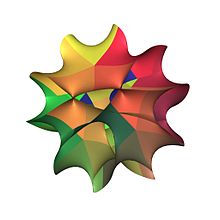
In mathematics, a Fermat quintic threefold is a special quintic threefold, in other words a degree 5, dimension 3 hypersurface in 4-dimensional complex projective space, given by the equation
- .
This threefold, so named after Pierre de Fermat, is a Calabi–Yau manifold.
The Hodge diamond of a non-singular quintic 3-fold is
| 1 | ||||||
| 0 | 0 | |||||
| 0 | 1 | 0 | ||||
| 1 | 101 | 101 | 1 | |||
| 0 | 1 | 0 | ||||
| 0 | 0 | |||||
| 1 |
Rational curves
Herbert Clemens (1984) conjectured that the number of rational curves of a given degree on a generic quintic threefold is finite. The Fermat quintic threefold is not generic in this sense, and Alberto Albano and Sheldon Katz (1991) showed that its lines are contained in 50 1-dimensional families of the form
for and . There are 375 lines in more than one family, of the form
for fifth roots of unity and .
References
- Albano, Alberto; Katz, Sheldon (1991), "Lines on the Fermat quintic threefold and the infinitesimal generalized Hodge conjecture", Transactions of the American Mathematical Society, 324 (1): 353–368, doi:10.2307/2001512, ISSN 0002-9947, JSTOR 2001512, MR 1024767
- Clemens, Herbert (1984), "Some results about Abel-Jacobi mappings", Topics in transcendental algebraic geometry (Princeton, N.J., 1981/1982), Annals of Mathematics Studies, vol. 106, Princeton University Press, pp. 289–304, MR 0756858
- Cox, David A.; Katz, Sheldon (1999), Mirror symmetry and algebraic geometry, Mathematical Surveys and Monographs, vol. 68, Providence, R.I.: American Mathematical Society, ISBN 978-0-8218-1059-0, MR 1677117
 .
.
 and
and  . There are 375 lines in more than one family, of the form
. There are 375 lines in more than one family, of the form

 and
and  .
.